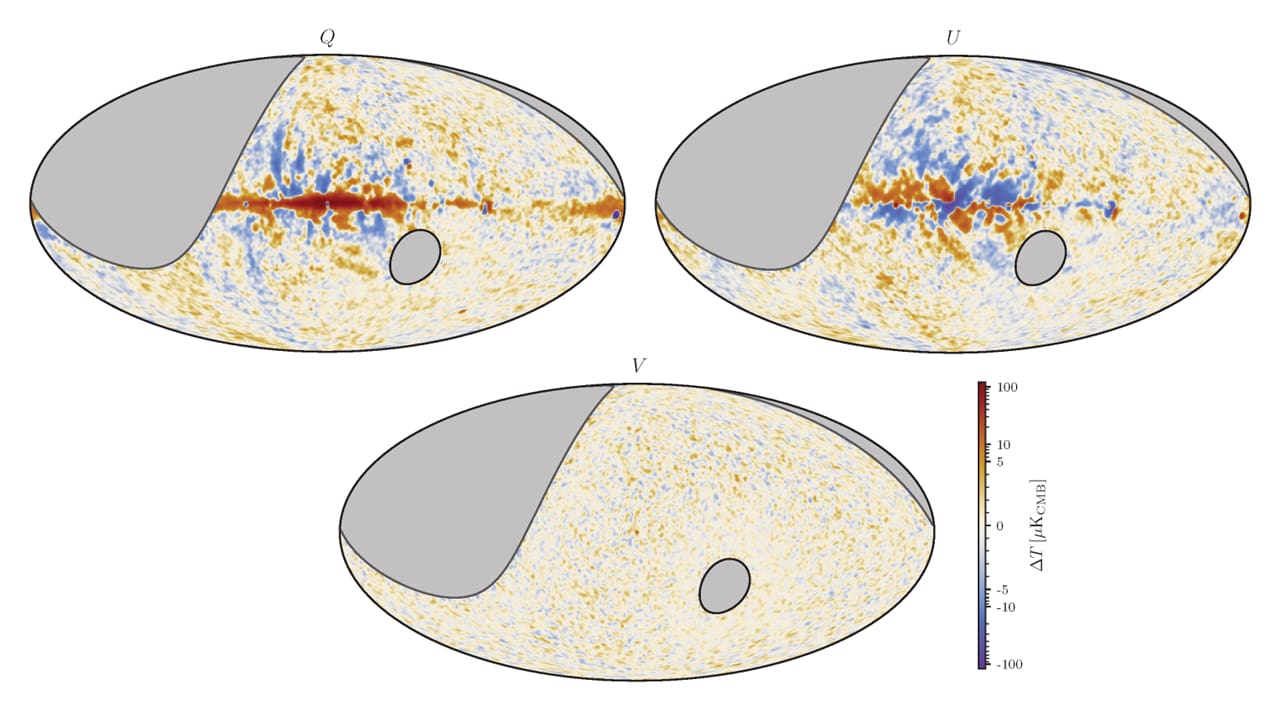The Cosmology Large Angular Scale Surveyor (CLASS) project aims to make a unique measurement of the Cosmic Microwave Background (CMB) that will transform our understanding of the universe and fundamental physics. This measurement will leave a far-reaching impact on the scientific community, the next generation of scientists, and the public. As electromagnetic radiation, the CMB has both an intensity and a polarization: It is the polarization of the CMB that CLASS will use to map over 70% of the sky.

New polarization maps from CLASS are pictured above. The polarization of light is characterized by three numbers called Stokes Parameters Q, U, and V, each represented here by an oval map. The oval maps capture the polarization in the night sky in the same way as oval geographical maps capture the surface of the earth: for every point in the sky there is a point on the oval sky map, just as each point on the earth can be found in an oval geographical map. The colors in the maps give the strength of the polarization at each point on the sky, as measured by CLASS. The measurements cover most of the maps because CLASS can observe most of the sky from Chile (75% of the total sky). These maps are an important advance in reconstructing large features in the polarization of the Cosmic Microwave Background and the Milky Way from an Earth-based observatory (versus from space), measurements which will ultimately tell us about when the first stars formed and the nature of the very early universe. For addition information, see the coverage of this result by NPR, space.com, and Interesting Engineering. These results were reported in our paper “CLASS Angular Power Spectra and Map-Component Analysis for 40 GHz Observations through 2022“, and the map data can be downloaded from NASA LAMBDA.
Discover CLASS
To know more about CLASS, explore the rest of our website and connect with us on Twitter if you have any questions or comments! Further information about the science and technology of CLASS can be found under Publications. To understand more about the project, visit our Science page and our Wikipedia page.
Acknowledgments
We acknowledge the National Science Foundation Division of Astronomical Sciences for their support of CLASS under Grant Numbers 0959349, 1429236, 1636634, 1654494, 2034400, and 2109311. The CLASS project employs detector technology developed under several previous and ongoing NASA grants. Detector development work at JHU was funded by NASA cooperative agreement 80NSSC19M0005. Data analysis for CLASS is conducted using computational resources of Advanced Research Computing at Hopkins (ARCH). We further acknowledge the very generous support of Jim Murren and Heather Miller (JHU A&S ’88), Matthew Polk (JHU A&S Physics BS ’71), David Nicholson, and Michael Bloomberg (JHU Engineering ’64). CLASS is located in the Parque Astronómico Atacama in northern Chile under the auspices of the Agencia Nacional de Investigación y Desarrollo (ANID).
